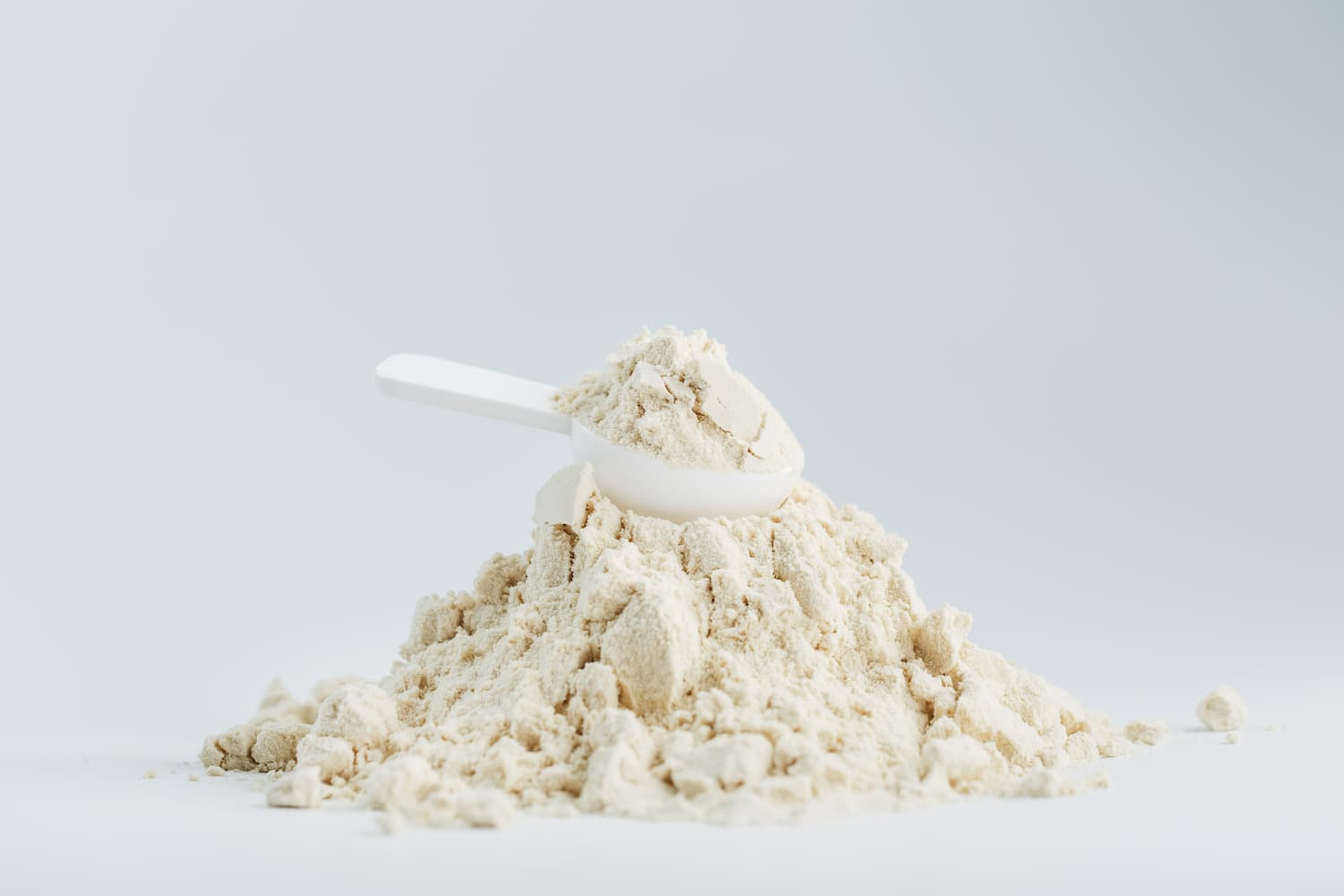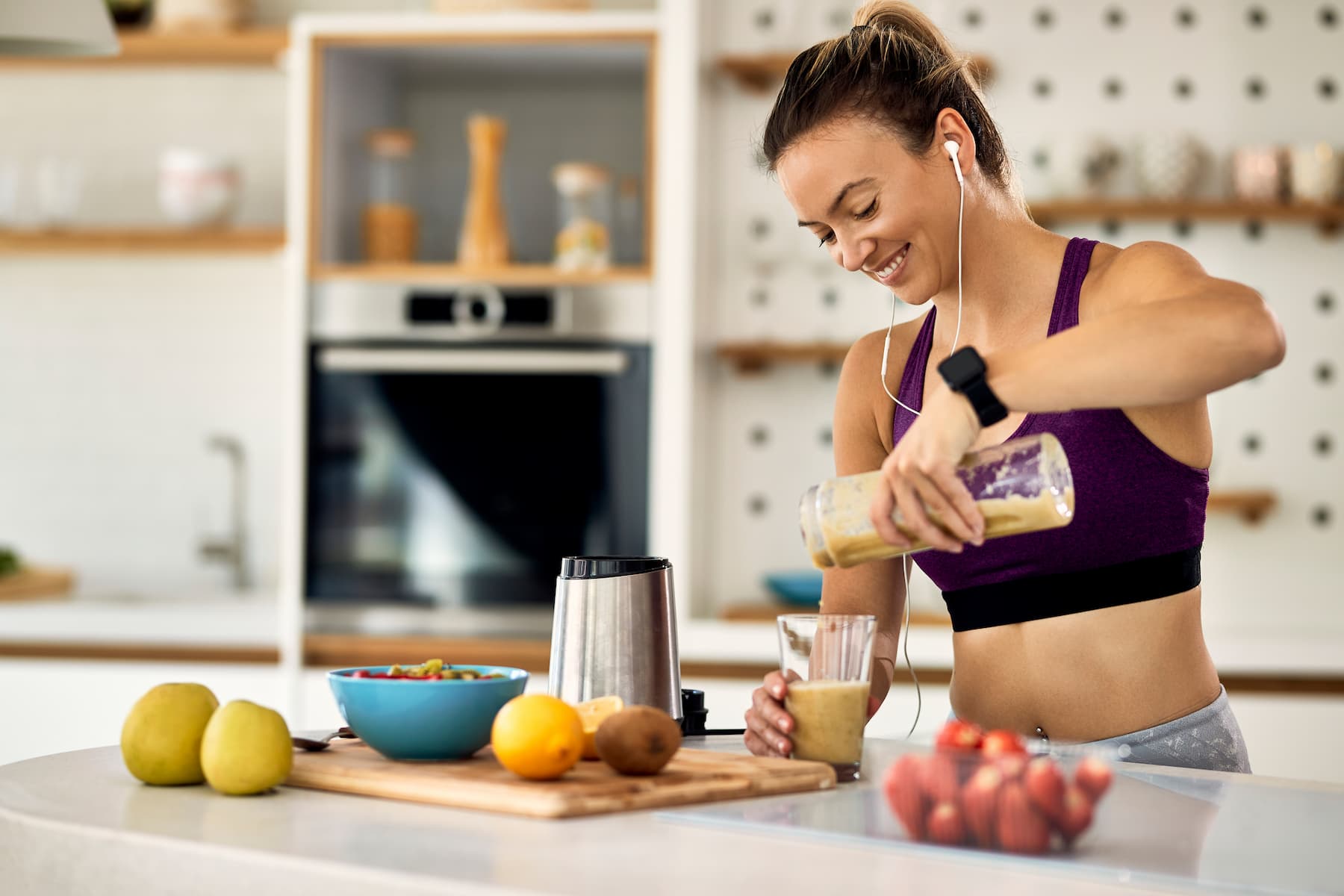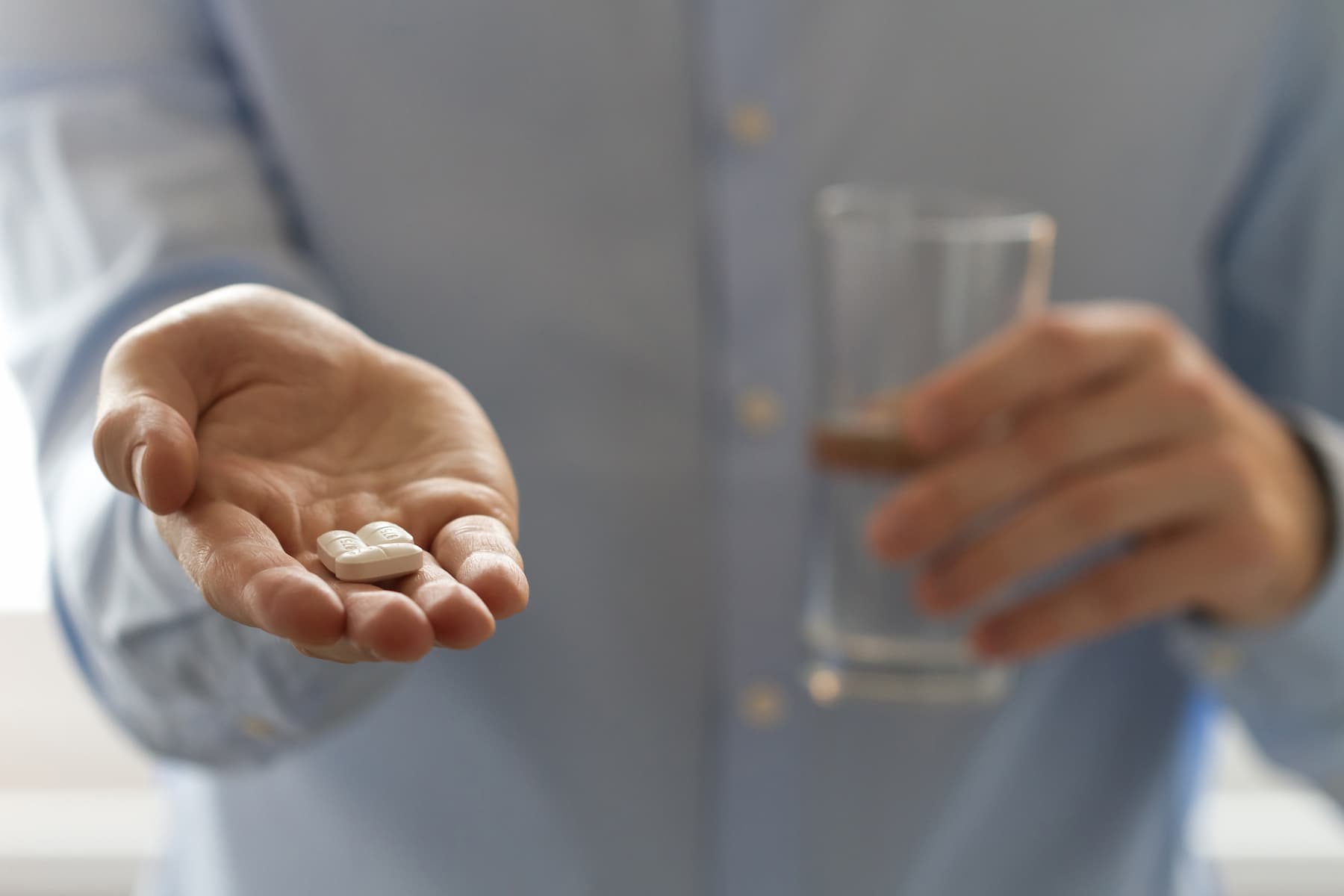Casein - what it is, where it occurs, intolerance and treatment
Casein is the main protein component of milk. It is a nutritionally rich protein, but also a potent allergen.


Learn more about our editorial process
.

Learn more about our editorial process
.

Learn more about our editorial process
.

Learn more about our editorial process
.
Why you can trust us
Articles on Natu.Care are written based on scientific research, data from government websites and other reliable sources. The texts are written in cooperation with doctors, nutritionists and other health and beauty experts. Articles are reviewed before publication and during significant updates.
.Learn more about our editorial process
.Information about advertisements
Content on Natu.Care may contain links to products from the sale of which we may receive a commission. When creating content, we adhere to high editorial standards and take care to be objective about the products discussed. The presence of affiliate links is not dictated by our partners, and we select the products we review ourselves completely independently.
.Learn more about our terms and Conditions
.Thanks to casein, milk is white (childhood mystery solved), amino acids in the body are replenished and protein supplements taste insane. Unfortunately, not everyone can have milk mustache, because casein is a strong allergen.
With nutritionist Kuba Pągowski, I will introduce you to the properties of casein and why it is called milk protein. And how to know if it's a bedtime protein for you because you have intolerance symptoms.
From this article you will learn:
- What is casein. .
- Where it occurs. .
- How to diagnose casein intolerance.
- How to diagnose casein intolerance.
- Why casein is popular among athletes. .
- Whether casein helps with weight loss. .
See also:
- Protein concentrate (WPC) .
- White protein isolate (WPI) .
- Protein hydrolysate (WPI) .
- Vegetable protein
- Protein before or after training? .
- How much protein a day? .
- Protein supplement
- Creatine
- BCAA
- Citrulline
Casein - what is it?
.Casein protein (commonly casein) is the main protein component of milk. It is responsible for its white colour and the high nutritional value of dairy products. It accounts for up to 80% of cow's milk protein (the remaining 20% is whey)and. Casein is the curd of milk and whey is the liquid part of it.
You can see this with the naked eye.
.Look at newly opened or unmixed yoghurt. This is an eyewitness example where you will see the whey-containing liquid separated from the solid mass of the yoghurt.
Casein also makes up about ⅓ of human milk protein..
 .
.
Kuba Pągowski clinical dietitian
Casein is commercially available in three formsand:
- micellar casein, .
- calcium caseinate, .
- casein hydrolysate, .
The different forms differ in the way sourcing from milk, content of nutrients and application.
Properties of casein
.Casein (in micellar form) is often chosen by people who do strength training, weight reduction and... love desserts. What do they appreciate casein so much forand?
- Contains all the essential amino acids you need to supply your body with from food.
- Has about 75g of protein per 100g and is a good complement to the protein in your diet. .
- Responsible for the high absorption of amino acids, which accelerate the process of regeneration and muscle mass building.
- Has anti-catabolic properties, that is, it prevents the breakdown of muscle tissue.
- Acts antioxidant. Peptides (protein fragments) secreted during the digestion of casein exhibit antioxidant properties. .
- The prolonged digestion of casein influences increased satiety after a meal and inhibits cravings, which is important for weight loss.
- Contains a lot calcium, which Poles consume too littleand. .
- Added to liquid, it takes on a tasty, dessert-like texture, which greatly increases the enjoyment of the meal.
Casein not just for cokeheads
Casein is not only used in protein nutrients, but is also used as an emulsifying, gelling, foaming or fat-binding agent. It is also used in cosmetic, industrial, bakery, confectionery and meat processingand.
Casein versus lactose
.Are casein and lactose the same thing? No, they are two different components found in milk. Their main differences areand:
- Structure. Casein is the main milk protein, and lactose is the milk sugar.
- Saccharide.
- Composition. Casein is the main milk protein and lactose is a complex sugar made up of two monosaccharides - glucose and galactose. .
- Functions. Casein primarily provides essential amino acids and is highly nutritious, while lactose has the function of providing energy, regulating the composition of intestinal flora and facilitating the absorption of other nutrients. .
- Lactose intolerance. Lactose intolerance is associated with a lack or insufficient amount of the enzyme lactase, which is responsible for the digestion of lactose. Casein can cause milk protein allergies, which are different from lactose intolerance. .
In summary: casein is a protein and lactose is a sugar present in milk. Casein is an important nutrient, while lactose functions as a milk sugar. Lactose intolerance is related to the lack of an enzyme to digest lactose, while milk protein allergies refer to a reaction to casein or other milk proteins.
Does lactose-free milk contain casein?
.Yes, lactose-free milk contains casein. Casein is a natural protein present in milk, independent of the presence of lactose. Lactose-free milk is a product in which the content of this milk sugar has been reduced or removed by adding the enzyme lactase, which breaks down lactose into glucose and galactose. Do not consume lactose-free milk if you are allergic to casein.
.Is casein harmful?
.Casein is harmful to people who are allergic to it and who are intolerant of dairy products. An allergy to this protein causes, among other things, abdominal pain, bloating, itchy skin and, in extreme cases, leads to anaphylactic shock. For people without allergies, however, it is safeand.
"After all, they make glue out of it, and you want to drink milk." - stumbled once on a certain health forum.
I reassure you - the casein used in the glue industry is processed and purified to achieve the correct adhesive properties. Pure food casein, which is found in dairy products for example, does not have the same structure or adhesive use as industrial caseinand.
Histories about gluing of organs or clogging of the intestines by milk are untrue and cause unnecessary anxiety. Until I have to drink...a glass of milk.
.What is micellar casein
.Micellar casein is the purest form in which casein protein is found. It contains 80-82% protein per 100 g of dry matter. Micellar casein is obtained by skimming and purifying milk of impurities and lactoseand.
Micellar casein is obtained at low temperature through a microfiltration process (without the use of chemicals). This yields a casein with an intact peptide structure with a high amount of L-glutamine and amino acids retained, including BCAAsand.
.Protein supplements Micellar Casein are a common choice among those in training. Athletes appreciate them for:
- the wealth of nutrients - calcium, phosphorus, essential amino acids, .
- slower release rate of amino acids, .
- long digestion time and high degree of satiety, .
Casein can be used as a meal replacement, unlike, for example, WPI nutrients. However, it is worth adding a source of carbohydrates and fats to maximise the nutritional value..
 .
.
Kuba Pągowskiclinical dietitian
ALLDEYNN WHEYROSE
Product description
Protein supplement containing whey protein concentrate (WPC) with added digestive enzymesós. It digests well, is an easy and quick way to provide protein and can be consumed by people with lactose intolerance. It will work well not only as a stand-alone drinkóy but also as a tasty addition to shakesóy, dessertsóy, oatmeal or omeletóy.
WHEYROSE contains five digestive enzymes that help break down macromolecules into smaller components, so that the ingredients from food and the nutrient are absorbed even better. This minimises or even eliminates digestive discomfort. Such an addition is rare in protein supplements.
.Pros and cons
Protein supplement containing whey protein concentrate (WPC) with added digestive enzymesós. It digests well, is an easy and quick way to provide protein and can be consumed by people with lactose intolerance. It will work well not only as a stand-alone drinkóy but also as a tasty addition to shakesóy, dessertsóy, oatmeal or omeletóy.
WHEYROSE contains five digestive enzymes that help break down macromolecules into smaller components, so that the ingredients from food and the nutrient are absorbed even better. This minimises or even eliminates digestive discomfort. Such an addition is rare in protein supplements.
.Additional information
Protein supplement containing whey protein concentrate (WPC) with added digestive enzymesós. It digests well, is an easy and quick way to provide protein and can be consumed by people with lactose intolerance. It will work well not only as a stand-alone drinkóy but also as a tasty addition to shakesóy, dessertsóy, oatmeal or omeletóy.
WHEYROSE contains five digestive enzymes that help break down macromolecules into smaller components, so that the ingredients from food and the nutrient are absorbed even better. This minimises or even eliminates digestive discomfort. Such an addition is rare in protein supplements.
.User review
Protein supplement containing whey protein concentrate (WPC) with added digestive enzymesós. It digests well, is an easy and quick way to provide protein and can be consumed by people with lactose intolerance. It will work well not only as a stand-alone drinkóy but also as a tasty addition to shakesóy, dessertsóy, oatmeal or omeletóy.
WHEYROSE contains five digestive enzymes that help break down macromolecules into smaller components, so that the ingredients from food and the nutrient are absorbed even better. This minimises or even eliminates digestive discomfort. Such an addition is rare in protein supplements.
.ALLDEYNN VEGEROSE
Product description
A protein supplement made from five plant proteins enriched with acacia fibre, flaxseed, MCT oil and the probiotic-prebiotic complex LactoWise®. It is a synbiotic thatós stimulates the developmentóy and growth of beneficial bacteria in the gastrointestinal tract and shows a beneficial effect on the condition of the digestive system.
Pros and cons
A protein supplement made from five plant proteins enriched with acacia fibre, flaxseed, MCT oil and the probiotic-prebiotic complex LactoWise®. It is a synbiotic thatós stimulates the developmentóy and growth of beneficial bacteria in the gastrointestinal tract and shows a beneficial effect on the condition of the digestive system.
Additional information
A protein supplement made from five plant proteins enriched with acacia fibre, flaxseed, MCT oil and the probiotic-prebiotic complex LactoWise®. It is a synbiotic thatós stimulates the developmentóy and growth of beneficial bacteria in the gastrointestinal tract and shows a beneficial effect on the condition of the digestive system.
Expert opinion
A protein supplement made from five plant proteins enriched with acacia fibre, flaxseed, MCT oil and the probiotic-prebiotic complex LactoWise®. It is a synbiotic thatós stimulates the developmentóy and growth of beneficial bacteria in the gastrointestinal tract and shows a beneficial effect on the condition of the digestive system.
ALLDEYNN VEGEROSE
Product description
A protein supplement made from five plant proteins enriched with acacia fibre, flaxseed, MCT oil and the probiotic-prebiotic complex LactoWise®. It is a synbiotic thatós stimulates the developmentóy and growth of beneficial bacteria in the gastrointestinal tract and shows a beneficial effect on the condition of the digestive system.
Pros and cons
A protein supplement made from five plant proteins enriched with acacia fibre, flaxseed, MCT oil and the probiotic-prebiotic complex LactoWise®. It is a synbiotic thatós stimulates the developmentóy and growth of beneficial bacteria in the gastrointestinal tract and shows a beneficial effect on the condition of the digestive system.
Additional information
A protein supplement made from five plant proteins enriched with acacia fibre, flaxseed, MCT oil and the probiotic-prebiotic complex LactoWise®. It is a synbiotic thatós stimulates the developmentóy and growth of beneficial bacteria in the gastrointestinal tract and shows a beneficial effect on the condition of the digestive system.
Expert opinion
A protein supplement made from five plant proteins enriched with acacia fibre, flaxseed, MCT oil and the probiotic-prebiotic complex LactoWise®. It is a synbiotic thatós stimulates the developmentóy and growth of beneficial bacteria in the gastrointestinal tract and shows a beneficial effect on the condition of the digestive system.
Protein supplements with micellar casein
.Micellar casein, like whey protein or soy protein, belongs to category "A" dietary supplements. The Australian Institute of Sport classifies products with scientifically proven efficacy into this categoryand.
Casein protein supplements are used to supplement the diet with protein, amino acids and calcium. They are free-absorbing, filling and very tasty.
.The price of nutrients Micellar Casein can vary depending on the manufacturer or additives. There is usually a higher cost compared to other protein sources (e.g. whey protein concentrate). Prices for casein supplements start at around £9/100g.
.Please note
.Leucine is the amino acid that has the greatest impact on the muscle-building processand. Whey protein contains approximately 26% more leucine than casein, so it may be more effective at stimulating muscle growthand. This is suggested by several scientific studies involving people of different ages and training stintsand.
Kuba Pągowski comments: If you eat a variety of foods then you don't need to worry about it anyway. Choose the nutrient that suits you better, e.g. in terms of taste.
.Protein at bedtime
.Casein is referred to as night protein, which is why it is recommended to take it as the last meal before bed. Casein will work well at night because of:
- Slow rate of absorption. This results in a long-lasting and stable supply of amino acids to the body for several hours after ingestion.
- Casein is a good choice for the nighttime meal.
- Anticatabolic effect.Casein can prevent muscle breakdown (catabolism) during overnight fasting. Provides the body with a constant source of building blocks for muscle rebuilding. Anti-catabolic effect.
- Satiety. Casein is much more satiating than whey protein. Its consumption before bed can increase feelings of fullness, satisfy appetite - which can be beneficial for people who want to control weight - and prevent nighttime snacking.
During sleep, when we do not provide the body with food for 7-12 hours, the muscles continue to use energy for, among other things, regeneration. Consuming a portion of protein will have a positive effect on muscle protein synthesis during the night. Casein, which releases amino acids into the blood over a longer period of time, can be particularly useful here..
 .
.
Kuba Pągowskiclinical dietitian
Your body digests and absorbs casein at a slower rate than whey protein. This is because the acidic environment in the stomach causes casein to solidify or form a gel. The stomach takes twice as long to digest and absorb the same amount of casein as wheyand.
Micellar casein for weight loss
.Micellar casein is a great way to lose weight, as this protein contains a high amount of valuable nutrients (including 9 essential amino acids), takes a long time to digest, prolongs the feeling of satiety, and when mixed with liquid, takes on a delicious velvety texture which increases meal satisfaction. Typically, 1 serving of 30g (and approximately 22g of protein in it) is used daily, preferably before bedtime.
Micellar casein in recipes
.Casein is the best common protein in cooking:
- replaces 80% of the flour in recipes, .
- rises well during baking, .
- naturally thickens liquids, .
- forms an elastic mass, .
Casein is my favourite protein in terms of taste and preparation options. Thick semolina with casein, waffles or sponge cake with this protein are super ideas for sneaking protein into a meal. No lumps or crumbling dough.
.Where does casein occur?
.Casein is primarily found in dairy products. However, you can also unknowingly consume it from other foods - even salty snacks! What is casein in?
.Content of casein in dairy products
.Products rich in casein areand:
.- cow's milk, .
- other animal milks (e.g. goat, sheep), .
- cottage cheese, .
- natural yoghurt, .
- dairy desserts, .
- kefir, .
- cottage cheese, .
- bread spreads (Philadelphia type), .
- buttermilk, .
- cream, .
- yellow cheese, .
- butter, .
- bread, .
- ice, .
And note, note casein can also be found in:
.- cured meats and other meat preparations, .
- confectionery products, .
- breakfast cereals, .
- confectionery,
- pastry products, and
- powdered sauces, .
- powdered cakes, .
- prepared meals,
- salted snacks, and
- salty snacks (e.g. crisps),
- food supplements.
- dietary supplements (e.g. protein supplements), .
Casein lurks in many foods, so if you have an allergy to this protein, read product labels carefully.
Casein intolerance
.Casein intolerance is the most severe form of cow's milk protein allergy. It is a condition where the body has difficulty digesting milk proteins, resulting in symptoms such as abdominal pain, bloating, diarrhoea and skin problemsand.
Food allergies to milk proteins - including casein - are most common among infants and children up to 3 years of age, and less common in adolescents and adults. During the first months of life, milk is the only, and later, essential component of a child's diet. The consumption of only one type of food, combined with the immaturity of the digestive tract, favours the development of allergies.
A higher risk of developing a cow's milk protein allergy is found in children whose at least one parent is allergic..
 .
.
Witold Tomaszewskidoctor of medical sciences
.Unlike other cow's milk proteins, allergy to casein is an allergy to which children will unfortunately not develop a tolerance as they grow older.
Why is casein allergic?
.Casein is allergenic because it is one of the so-called thermostable proteins, whose allergenic properties are not abolished by cooking even at high temperatures.
Casein allergy is an allergenic protein.
A casein allergy occurs when the immune system recognises the casein protein as "harmful". As a result, an immune response involving IgE antibodies and histamine is triggered, resulting in certain discomforts on the part of multiple systems in the body.
Symptoms of casein allergy
.Symptoms of casein allergy includeand:
.- abdominal pain, .
- congestion, .
- constipation, .
- diarrhoea, .
- vomiting, .
- itching of the skin, .
- difficulty breathing, .
Rarely, but in extreme cases, anaphylactic shock can occurand.
Anaphylactic shock is an immediate and life-threatening allergic reaction that can occur after exposure to an allergen. Shock is caused by the release of large amounts of histamine and other chemicals by the immune system in response to contact with an allergen.
 .
.
Witold Tomaszewskidoctor of medical sciences
.How to test for a casein allergy
.You can test for a casein allergy by having a skin test or blood test at a laboratory outlet.
During the skin test small amounts of casein extract are applied to the skin. The skin is then gently pricked to allow the substance to come into contact with the immune system. Casein sensitisation manifests as redness, petechiae or swelling in the test area.
Blood tests such as the RAST test or IgE antibody tests can also confirm casein allergy. During the test, a blood sample is taken and then the presence of IgE antibodies directed against casein is tested.
Casein allergy test - how to prepare?
.Taking a skin test or blood test does not require any special preparation. You do not need to be fasting and you can take your medication normally if you are taking it on a regular basis.
Treatment of casein intolerance
.Unfortunately, there is no effective treatment for casein intolerance with medication. Once a cow's milk protein allergy has been confirmed, dairy products must be eliminated from your diet in any form. This ensures that you do not expose your body to the allergen.
.Dairy products are an important source of calcium, so people with casein intolerance should make sure they are getting adequate amounts of this mineral from other sources, such as plant-based beverages, high-mineralised water, fish, seeds, nuts, green vegetables.
 .
.
Kuba Pągowski clinical dietitian
.Does casein intolerance pass?"
.Unfortunately, casein intolerance does not pass with age or with the reduction of dairy products in the diet. Casein allergy is a chronic condition, just like lactose intolerance. This means that it does not pass on its own, but can be controlled by avoiding foods containing casein.
What to eat when you have casein intolerance
.When suffering from casein intolerance, it is a good idea to add foods to the menu that will replenish the body with valuable nutrients and replace milk:
.- Vegetable beverages. Soya milk, almond milk, coconut milk, rice milk, hemp milk or oat milk are all widely available products that are great alternatives to animal milk.
- Products that can be used as a substitute for animal milk.
- Vegetable-based products. You will find a wide range of plant-based cheeses and yogurts on the market, such as soy, almond, coconut or chia seed yogurt. .
- Alternative sources of calcium. Products such as sesame, walnuts, sardines, broccoli, spinach, soya, tofu, chia seeds and amaranth can provide calcium, which is an important component of milk.
In the case of casein intolerance, it is worth consulting a nutritionist who will develop personalised dietary recommendations. It is also important to read labels carefully and avoid products containing casein (which are sometimes non-obvious) or other dairy products.
Casein affects hair?
.It's in beans, in glue and even in... your shampoo. I asked Catherine Srebr, a cosmetologist, about the use of casein in cosmetics.
Hydrolysed casein forms an occlusive layer (film) on the surface of the hair, which prevents excessive evaporation of water from the hair surface. It has an indirect moisturising, softening and smoothing effect on the skin and hair..
 .
.
Katarzyna SrebrCosmetologist
Hydrolysed casein can be found in shampoos, conditioners or masks. It may also be present in some skincare products, such as creams or balms.
Summary
.- Casein (casein protein) is the main protein component of milk. It accounts for up to 80% of cow's milk protein.
- Casein (casein protein) is a major component of milk protein.
- The richest dairy products in casein are cow's milk, other animal milks (e.g. goat's milk, sheep's milk), cottage cheese, natural yoghurt, dairy desserts, .
- Casein contains all the essential amino acids, which support muscle building and have anti-catabolic and antioxidant effects.
- Drinking a nutritional supplement with micellar casein provides complete protein and plenty of calcium, and increases satiety after a meal.
- Casein intolerance is the most severe form of cow's milk protein allergy. It causes symptoms such as abdominal pain, bloating, diarrhoea and skin problems.
- Casein intolerance is the most severe form of allergy.
- Casein intolerance cannot be cured, casein must be eliminated from the diet. .
FAQ
.Do protein supplements with casein contain lactose?
.Casein, a protein found naturally in milk, contains lactose and milk sugar. Protein supplements with casein that have been lactose-separated or manufactured to contain very low levels of lactose, but are not lactose-free.
Is whey casein?
.No, whey is not the same as casein. Both are components of milk protein with different properties and uses in food and supplementation. Casein accounts for 80% of all proteins in milk, with whey accounting for the remaining 20%.
Whey (whey) is one of the milk protein components that is separated during the cheese-making process. It is a liquid fraction of protein with high nutritional value. It contains a complete profile of amino acids and is well absorbed by the body.
Casein (casein), on the other hand, is the main component of milk protein. This protein is more difficult to digest and has a delayed rate of amino acid release, meaning it is absorbed more slowly by the body. Therefore, it is often used as an ingredient in protein supplements used before bedtime.
What kind of butter on a dairy-free diet?
.On the dairy-free diet you can consume:
- clear butter, .
- soy margarine, .
- avocado butter, .
- coconut butter, .
- nut butter, .
- hummus, .
- vegetable spreads, e.g. from beans, .
- vegetable pastes, .
There are also alternative products that are a good substitute for butter in recipes (e.g. oils) or as a spread for bread (e.g. vegan cheese).
Which milk does not contain casein?
.Every milk contains casein, but plant-based drinks come to the rescue. Casein-free milk alternatives include soya milk, oat milk, almond milk, coconut milk and rice milk. Soy milk is particularly worth looking out for, as it is low in fat and rich in protein and calcium, which is important for those on a dairy-free diet. When buying plant-based drinks, choose those with added calcium, and shake them before drinking, as the added calcium settles to the bottom of the carton.
Protein conditioner with casein - where to buy?
.You can buy casein protein supplements stationary and online in health food shops, sports shops, pharmacies and drugstores.
Is there casein in butter?
.Yes, classic butter (made from milk) contains casein. However, there are dairy-free alternatives, such as vegetable butter or margarine, which do not contain casein. It is always worth checking labels to ensure that butter does not contain milk or its ingredients.
What is better casein or WPC?
.Casein and WPC (whey protein concentrate) are two different forms of protein. Casein is a slowly digested protein that satiates for long periods of time and is popularly used before bed.
WPC is a whey protein that is absorbed fairly quickly after ingestion and is often used as a post-workout supplement. The choice depends on individual preferences and needs.
Sources
.See all
.Bilsborough, S., & Mann, N. (2006). A review of issues of dietary protein intake in humans. International Journal of Sport Nutrition and Exercise Metabolism, 16(2), 129-152. https://doi.org/10.1123/ijsnem.16.2.129
Bos, C., Metges, C. C., Gaudichon, C., Petzke, K. J., Pueyo, M. E., Morens, C., Everwand, J., Benamouzig, R., & Tomé, D. (2003). Postprandial kinetics of dietary amino acids are the main determinant of their metabolism after soy or milk protein ingestion in humans. The Journal of Nutrition, 133(5), 1308-1315. https://doi.org/10.1093/jn/133.5.1308
Bučević-Popović, V., Delaš, I., Međugorac, S., Pavela-Vrančić, M., & Kulišić-Bilušić, T. (2014). Oxidative stability and antioxidant activity of bovine, caprine, ovine and asinine milk. International Journal of Dairy Technology, 67(3), 394-401. https://doi.org/10.1111/1471-0307.12126
Burd, N. A., Yang, Y., Moore, D. R., Tang, J. E., Tarnopolsky, M. A., & Phillips, S. M. (2012). Greater stimulation of myofibrillar protein synthesis with ingestion of whey protein isolate v. Micellar casein at rest and after resistance exercise in elderly men. The British Journal of Nutrition, 108(6), 958-962. https://doi.org/10.1017/S0007114511006271
Dangin, M., Guillet, C., Garcia-Rodenas, C., Gachon, P., Bouteloup-Demange, C., Reiffers-Magnani, K., Fauquant, J., Ballèvre, O., & Beaufrère, B. (2003). The rate of protein digestion affects protein gain differently during aging in humans. The Journal of Physiology, 549(Pt 2), 635-644. https://doi.org/10.1113/jphysiol.2002.036897
Demling, R. H., & DeSanti, L. (2000). Effect of a hypocaloric diet, increased protein intake and resistance training on lean mass gains and fat mass loss in overweight police officers. Annals of Nutrition & Metabolism, 44(1), 21-29. https://doi.org/10.1159/000012817
Deshwal, G. K., Gómez-Mascaraque, L. G., Fenelon, M., & Huppertz, T. (2023). A Review on the Effect of Calcium Sequestering Salts on Casein Micelles: From Model Milk Protein Systems to Processed Cheese. Molecules, 28(5), Article 5. https://doi.org/10.3390/molecules28052085
Gorissen, S. H. M., Crombag, J. J. R., Senden, J. M. G., Waterval, W. A. H., Bierau, J., Verdijk, L. B., & van Loon, L. J. C. (2018). Protein content and amino acid composition of commercially available plant-based protein isolates. Amino Acids, 50(12), 1685-1695. https://doi.org/10.1007/s00726-018-2640-5
Kim, J. (2020). Pre-sleep casein protein ingestion: New paradigm in post-exercise recovery nutrition. Physical Activity and Nutrition, 24(2), 6-10. https://doi.org/10.20463/pan.2020.0009
Küllenberg de Gaudry, D., Lohner, S., Schmucker, C., Kapp, P., Motschall, E., Hörrlein, S., Röger, C., & Meerpohl, J. J. (2019). Milk A1 β-casein and health-related outcomes in humans: A systematic review. Nutrition Reviews, 77(5), 278-306. https://doi.org/10.1093/nutrit/nuy063
Li, Z., Jiang, A., Yue, T., Wang, J., Wang, Y., & Su, J. (2013). Purification and identification of five novel antioxidant peptides from goat milk casein hydrolysates. Journal of Dairy Science, 96(7), 4242-4251. https://doi.org/10.3168/jds.2012-6511
Miller, M. J., Witherly, S. A., & Clark, D. A. (1990). Casein: A milk protein with diverse biological consequences. Proceedings of the Society for Experimental Biology and Medicine. Society for Experimental Biology and Medicine (New York, N.Y.), 195(2), 143-159. https://doi.org/10.3181/00379727-195-43129
Muñoz Martín, T., de la Hoz Caballer, B., Marañón Lizana, F., González Mendiola, R., Prieto Montaño, P., & Sánchez Cano, M. (2004). Selective allergy to sheep's and goat's milk proteins. Allergologia Et Immunopathologia, 32(1), 39-42. https://doi.org/10.1016/s0301-0546(04)79222-8
Rival, S. G., Boeriu, C. G., & Wichers, H. J. (2001). Caseins and Casein Hydrolysates. 2. Antioxidative Properties and Relevance to Lipoxygenase Inhibition. Journal of Agricultural and Food Chemistry, 49(1), 295-302. https://doi.org/10.1021/jf0003911
Snijders, T., Trommelen, J., Kouw, I. W. K., Holwerda, A. M., Verdijk, L. B., & van Loon, L. J. C. (2019). The Impact of Pre-sleep Protein Ingestion on the Skeletal Muscle Adaptive Response to Exercise in Humans: An Update. Frontiers in Nutrition, 6, 17. https://doi.org/10.3389/fnut.2019.00017
Sutanto, C. N., Loh, W. W., Toh, D. W. K., Lee, D. P. S., & Kim, J. E. (2022). Association Between Dietary Protein Intake and Sleep Quality in Middle-Aged and Older Adults in Singapore. Frontiers in Nutrition, 9, 832341. https://doi.org/10.3389/fnut.2022.832341
Tang, J. E., Moore, D. R., Kujbida, G. W., Tarnopolsky, M. A., & Phillips, S. M. (2009). Ingestion of whey hydrolysate, casein, or soy protein isolate: Effects on mixed muscle protein synthesis at rest and following resistance exercise in young men. Journal of Applied Physiology, 107(3), 987-992. https://doi.org/10.1152/japplphysiol.00076.2009
Trommelen, J., Kouw, I. W. K., Holwerda, A. M., Snijders, T., Halson, S. L., Rollo, I., Verdijk, L. B., & van Loon, L. J. C. (2018). Presleep dietary protein-derived amino acids are incorporated in myofibrillar protein during postexercise overnight recovery. American Journal of Physiology. Endocrinology and Metabolism, 314(5), E457-E467. https://doi.org/10.1152/ajpendo.00273.2016
Trommelen, J., Weijzen, M. E. G., van Kranenburg, J., Ganzevles, R. A., Beelen, M., Verdijk, L. B., & van Loon, L. J. C. (2020). Casein Protein Processing Strongly Modulates Post-Prandial Plasma Amino Acid Responses In Vivo in Humans. Nutrients, 12(8), 2299. https://doi.org/10.3390/nu12082299
Wilborn, C. D., Taylor, L. W., Outlaw, J., Williams, L., Campbell, B., Foster, C. A., Smith-Ryan, A., Urbina, S., & Hayward, S. (2013). The Effects of Pre- and Post-Exercise Whey vs. Casein Protein Consumption on Body Composition and Performance Measures in Collegiate Female Athletes. Journal of Sports Science & Medicine, 12(1), 74-79.
.Wirth, J., Hillesheim, E., & Brennan, L. (2023). Protein intake and its effect on sleep outcomes: A systematic review and meta-analysis of randomized controlled trials. Nutrition Reviews, 81(3), 333-345. https://doi.org/10.1093/nutrit/nuac061
Zhou, J., Kim, J. E., Armstrong, C. L., Chen, N., & Campbell, W. W. (2016). Higher-protein diets improve indices of sleep in energy-restricted overweight and obese adults: Results from 2 randomized controlled trials123. The American Journal of Clinical Nutrition, 103(3), 766-774. https://doi.org/10.3945/ajcn.115.124669
Editorials
Meet the team



Vegan protein supplements add protein to the diets of athletes and non-athletes alike.

Look after the protein in your diet whether you are on a weight gain, weight reduction or weight maintenance.

Methionine is a little-known amino acid that is responsible for many functions in the body.



